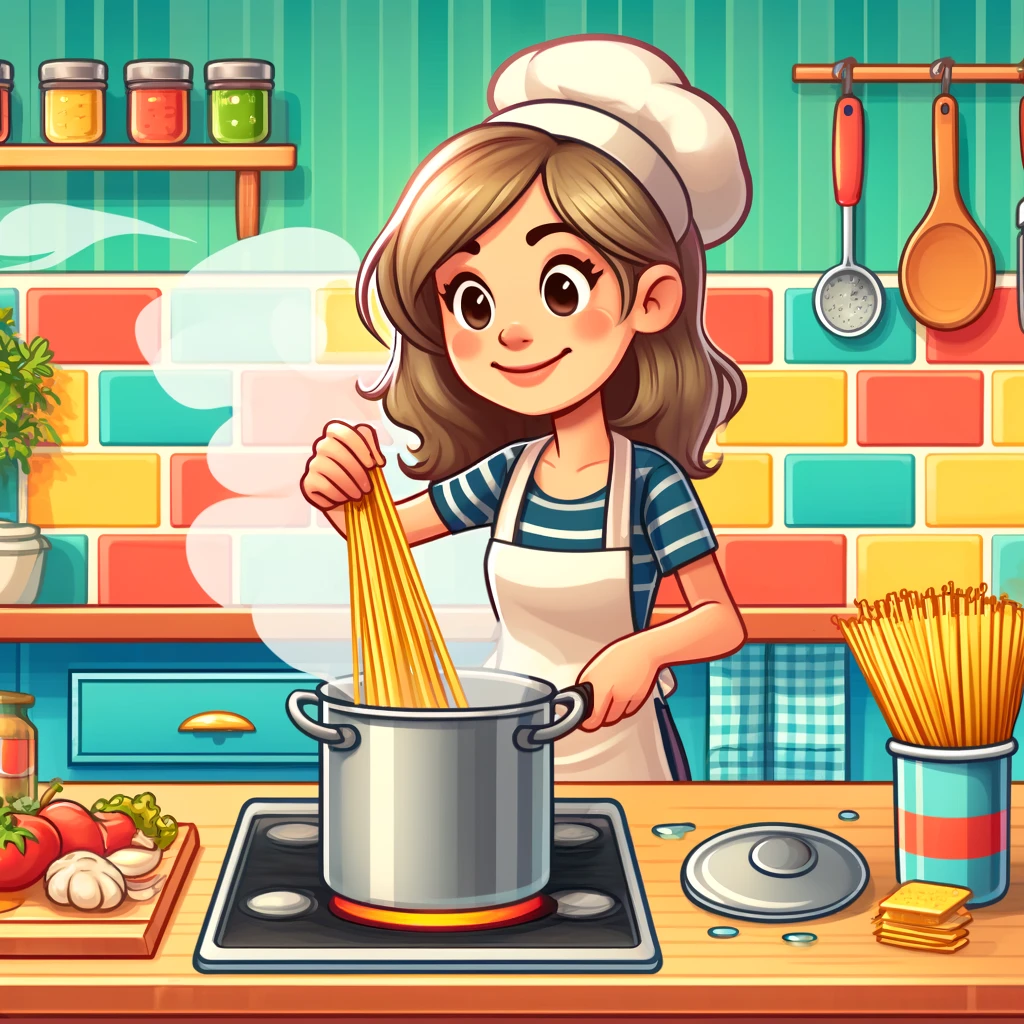Ladies and gentlemen, gather ’round, for I am about to impart upon you the sacred knowledge of boiling spaghetti. Yes, you read that right. Boiling. Spaghetti. Two words that strike fear into the hearts of even the most seasoned chefs. But fear not, my dear readers, for I shall guide you through this treacherous journey with wit, wisdom, and a healthy dose of sarcasm.
The Importance of Boiling Spaghetti
You may be thinking, “Why do I need to learn how to boil spaghetti? Can’t I just order takeout?” Well, my friend, let me tell you a little story. Once upon a time, there was a young lad named Jimmy who thought the same thing. He scoffed at the idea of cooking his own meals, preferring instead to rely on the convenience of delivery apps. But one fateful night, as he waited for his spaghetti bolognese to arrive, disaster struck. The delivery driver got lost, the restaurant closed, and Jimmy was left hungry and alone, with nothing but a box of uncooked spaghetti to keep him company. Don’t be like Jimmy. Learn how to boil spaghetti.
Gathering Your Supplies
Before we embark on this culinary adventure, let’s make sure you have all the necessary supplies. You will need:
- A pot (preferably one with a lid, but if you don’t have one, just use a frisbee or a hubcap)
- Water (if you don’t have any, just use your tears of frustration)
- Salt (stolen from your neighbor’s sidewalk during winter is preferred)
- Spaghetti (obviously)
- A colander (or a clean sock, if you’re feeling adventurous)
- A stove (or a bonfire, if you’re camping)
Choosing the Right Pot
The first step in boiling spaghetti is choosing the right pot. Now, some may say that size doesn’t matter, but in this case, it absolutely does. You want a pot that’s big enough to accommodate your spaghetti without overcrowding. If you’re cooking for one, a small saucepan will suffice. If you’re cooking for a family of four, you might want to use a stockpot. And if you’re cooking for an army, well, you might want to consider using a bathtub.
Filling the Pot with Water
Once you’ve selected your pot, it’s time to fill it with water. Now, I know what you’re thinking. “Water? That’s it? No magic ingredient?” Trust me, my friend, water is the magic ingredient. It’s the elixir of life, the source of all things good and pure. Plus, it’s free (unless you live in a city with a water tax, in which case, I’m sorry).
But how much water should you use? Well, that depends on how much spaghetti you’re cooking. A good rule of thumb is to use about 4 quarts of water for every pound of spaghetti. But if you’re like me and don’t own measuring cups, just fill the pot about three-quarters of the way full. And if you’re really lazy, just fill it up to the brim and hope for the best.
Adding Salt to the Water
Now, some people may tell you that adding salt to the water is optional. Those people are wrong. Salt is essential to the spaghetti-boiling process. It not only adds flavor to the pasta, but it also helps to keep the spaghetti from sticking together. And let’s be honest, there’s nothing worse than a clump of spaghetti that refuses to be separated, no matter how much you stab at it with your fork.
But how much salt should you add? Well, that depends on your personal preference. Some people like their spaghetti to be as salty as the ocean, while others prefer a more subtle flavor. I recommend starting with a tablespoon of salt per pound of spaghetti, and then adjusting to taste. And if you accidentally add too much salt, just add more water. Or, if you’re feeling really adventurous, add some sugar to balance it out. (Disclaimer: I am not responsible for any culinary disasters that may result from this advice.)
Bringing the Water to a Boil
Now that you’ve filled your pot with water and added salt, it’s time to bring the water to a boil. This is where things can get a little tricky, especially if you’re easily distracted like me. You see, watching water boil is about as exciting as watching paint dry, except with the added danger of getting scalded by steam.
To make things more interesting, I like to play a little game called “Is It Boiling Yet?” The rules are simple: stare at the water and try to guess when it will start boiling. If you guess correctly, congratulations! You win nothing. If you guess incorrectly, well, you also win nothing. But at least you’ve passed the time.
Adding the Spaghetti
Once the water is boiling, it’s time to add the spaghetti. Now, I know what you’re thinking. “Do I really need instructions on how to add spaghetti to water?” Yes, yes you do. Because believe it or not, there is a right way and a wrong way to do it.
First, make sure you have your spaghetti ready. If you’re using boxed spaghetti, open the box and remove the plastic packaging. If you’re using fresh spaghetti, well, la-di-da, aren’t you fancy?
Next, take a handful of spaghetti and gently place it in the boiling water. Do not, I repeat, do not just dump the entire box of spaghetti into the pot at once. This will result in a tangled mess of pasta that will be impossible to separate, and you’ll end up with a giant spaghetti ball instead of individual noodles.
Instead, add the spaghetti gradually, a handful at a time, until it’s all in the pot. Then, using a fork or a pasta spoon (if you’re one of those fancy people who owns a pasta spoon), gently stir the spaghetti to make sure it’s not sticking together.
Cooking the Spaghetti
Now that your spaghetti is in the pot, it’s time to let it cook. But for how long, you ask? Well, that depends on the type of spaghetti you’re using and your personal preference for doneness.
If you’re using boxed spaghetti, the cooking time should be listed on the package. But if you’re like me and you threw away the package in a fit of excitement, here’s a general guide:
- For al dente spaghetti (firm to the bite), cook for 8-10 minutes
- For soft spaghetti, cook for 10-12 minutes
- For mushy spaghetti (why would you want this?), cook for 12-15 minutes
But here’s the thing: these are just guidelines. The only way to know for sure if your spaghetti is done is to taste it. And I don’t mean just nibbling on a strand like a dainty little mouse. No, I mean taking a big, bold bite and really savoring the flavor and texture.
If the spaghetti is too firm, let it cook for a minute or two longer. If it’s too soft, well, I’m sorry, but you’ve overcooked it and there’s no going back. You’ll just have to live with your mistake and try again next time.
Draining the Spaghetti
Once your spaghetti is cooked to perfection, it’s time to drain it. This is where the colander (or clean sock) comes in handy. Place the colander in the sink and carefully pour the pot of spaghetti and water into it. Be careful not to burn yourself on the steam, and try not to let any spaghetti escape down the drain. (If you do, just pretend it never happened and move on with your life.)
If you don’t have a colander, you can also use a lid to strain the spaghetti. Just place the lid on top of the pot, leaving a small gap for the water to escape, and carefully pour out the water. Again, be careful not to let any spaghetti escape, or you’ll be left with a very sad and lonely pot of water.
Serving the Spaghetti
Congratulations, you’ve successfully boiled spaghetti! Now it’s time to serve it up and enjoy the fruits of your labor. But how, you ask? Well, there are a few options:
- The Classic Twirl: Using a fork, twirl a small amount of spaghetti around the tines until you have a neat little bundle. Then, carefully lift the fork to your mouth and enjoy. Repeat until all the spaghetti is gone or until you’re too full to move.
- The Slurp: This method is not for the faint of heart. Simply lift a strand of spaghetti to your mouth and slurp it up like a noodle-loving vacuum cleaner. Be warned, this method can be messy and may result in sauce splatters on your shirt, face, and anyone unfortunate enough to be sitting near you.
- The Cut: If you’re one of those people who likes to play it safe, you can always cut your spaghetti into bite-sized pieces with a knife and fork. This method is neat, tidy, and completely boring. But hey, you do you.
Conclusion
And there you have it, folks. A comprehensive guide to boiling spaghetti, complete with wit, wisdom, and a healthy dose of sarcasm. I hope you’ve learned something today, even if it’s just that I have way too much time on my hands.
But in all seriousness, boiling spaghetti is a life skill that everyone should master. It’s cheap, easy, and versatile, and it can be the foundation for countless delicious meals. So go forth, my dear readers, and boil spaghetti with confidence. And if all else fails, just order takeout. (But don’t be like Jimmy. Always have a backup plan.)
Recent Posts
So, you think you have what it takes to compete in a spicy food contest? You've watched countless videos of people sweating, crying, and questioning their life choices as they chow down on ghost...
Forget kale smoothies and yoga retreats, the real secret to a long and healthy life is none other than the golden elixir of whiskey. That's right, folks, whiskey isn't just for drowning your sorrows...

